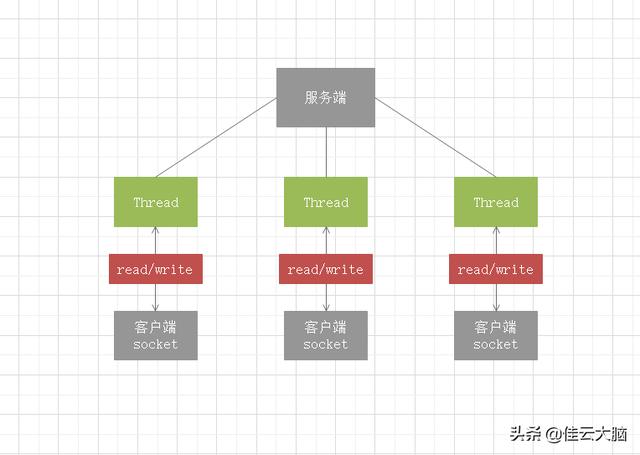作者 | 小高飞
来源 | urlify.cn/BBbuIn
BIO
BIO(Blocking I/O),同步阻塞,实现模式为一个连接一个线程,即当有客户端连接时,服务器端需为其单独分配一个线程,如果该连接不做任何操作就会造成不必要的线程开销。BIO是传统的Java io编程,其相关的类和接口在java.io 包下。
BIO适用于连接数目较小且固定的架构,对服务器资源的要求较高,是JDK1.4以前的唯一选择,但程序简单易理解。

BIO编程流程
- 服务器端启动一个SeverSocket
- 客户端启动Socket对服务器端发起通信,默认情况下服务器端需为每个客户端创建一个线程与之通讯
- 客户端发起请求后,先咨询服务器端是否有线程响应,如果没有则会等待或被拒绝
- 如果有线程响应,客户端线程会等待请求结束后,再继续执行
简单代码实现
//BIO-服务器端public class BIOSever { public static void main(String[] args) throws IOException { //在BIO中,可以使用线程池进行优化 ExecutorService cachedThreadPool = Executors.newCachedThreadPool(); ServerSocket serverSocket = new ServerSocket(6666); System.out.println("服务器已启动"); while (true){ System.out.println("等待客户端连接.....(阻塞中)"); Socket socket = serverSocket.accept(); System.out.println("客户端连接"); cachedThreadPool.execute(new Runnable() { public void run() { handler(socket); } }); } } //从客服端socket读取数据 public static void handler(Socket socket){ try{ InputStream inputStream = socket.getInputStream(); byte[] b = new byte[1024]; while (true){ System.out.println("等待客户端输入.....(阻塞中)"); int read = inputStream.read(b); if (read != -1){ System.out.println(new String(b, 0, read)); }else { break; } } inputStream.close(); }catch (Exception e){ e.printStackTrace(); }finally { try { socket.close(); } catch (IOException e) { e.printStackTrace(); } } }}//BIO-客户端public class BIOClient { public static void main(String[] args) throws IOException { Socket socket = new Socket("localhost", 6666); OutputStream outputStream = socket.getOutputStream(); Scanner scanner = new Scanner(System.in); while (scanner.hasNextLine()){ String message = scanner.nextLine(); if ("exit".equals(message)) { break; } outputStream.write(message.getBytes()); } outputStream.close(); socket.close(); }}BIO问题分析
从上面代码中可以看出BIO编程的两个问题:
- 服务器端在监听客户端连接时(serverSocket.accept()),服务器端处于阻塞状态,不能处理其他事务
- 服务器端需要为每个客户端建立一个线程,虽然可以用线程池来优化,但在并发较大时,线程开销依旧很大
- 当连接的客户端没有发送数据时,服务器端会阻塞在read操作上,等待客户端输入,造成线程资源浪费
NIO
从JDK1.4开始,java提供了一系列改进输入/输出的新特性,统称为NIO,全称n为new I/O,是同步非阻塞的,所以也有人称为non-blocking I/O。NIO的相关类都放在java.nio包或其子包下,并对原先java.io包中许多类进行了改写。

NIO的三大核心
缓冲区(Buffer)
NIO是面向缓冲区, 或者说是面向块编程的。在NIO的IO传输中,数据会先读入到缓冲区,当需要时再从缓冲区写出,这样减少了直接读写磁盘的次数,提高了IO传输的效率。
缓冲区(buffer)本质上是一个可以读写数据的内存块,即在内存空间中预留了一定的存储空间,这些存储空间用来缓冲输入和输出的数据,这部分预留的存储空间就叫缓冲区。
在NIO程序中,通道channel虽然负责数据的传输,但是输入和输出的数据都必须经过缓冲区buffer。

在java中,缓冲区的相关类都在java.nio包下,其最顶层的类是 Buffer,它是一个抽象类。
Buffer类的4个重要属性:
- mark:标记
- position:位置,下一个要被读或写的元素的索引,每次读写缓冲区都会改变该值,为下次读写做准备
- limit:表示缓冲区的终点,不能对缓冲区中超过极限的位置进行读写操作,且极限是可修改的
- capacity:容量,即缓冲区的最多可容纳的数据量,该值在创建缓冲区时被设立,且不可修改
Buffer类常用方法:

Buffer的常用子类(它们之间最大区别在于底层实现数组的数据类型):
- ByteBuffer:存储字节数据到缓冲区
- CharBuffer:存储字符数据到缓冲区
- IntBuffer:存储整型数据到缓冲区
- ShortBuffer:存储短整型数据到缓冲区
- LongBuffer:存储长整型数据到缓冲区
- FloatBuffer:存储浮点型数据到缓冲区
- DoubleBuffer:存储双精度浮点型数据到缓冲区
ByteBuffer
在Buffer的所有子类中,最常用的还是ByteBuffer,它的常用方法:

通道(Channel)
在NIO程序中服务器端和客户端之间的数据读写不是通过流,而是通过通道来读写的。
通道类似于流,都是用来读写数据的,但它们之间也是有区别的:
- 通道是双向的,即可以读也可以写,而流是单向的,只能读或写
- 通道可以实现异步读写数据
- 通道可以从缓冲区读数据,也可以把数据写入缓冲区
java中channel的相关类在java.nio.channel包下。Channel是一个接口,其常用的实现类有:
- FileChannel:用于文件的数据读写,其真正的实现类为FileChannelImpl
- DatagramChannel:用于UDP的数据读写,其真正的实现类为DatagramChannelImpl
- ServerSocketChannel:用于监听TCP连接,每当有客户端连接时都会创建一个SocketChannel,功能类似ServerSocket,其真正的实现类为ServerSocketChannelImpl
- SocketChannel:用于TCP的数据读写,功能类似节点流+Socket,其真正的实现类为SocketChannelImpl
FileChannel
FileChannel主要用于对本地文件进行IO操作,如文件复制等。它的常用方法有:

在文件传输流中有个属性channel,它默认是空的,可以通过流中的getChanel()方法根据当前文件流的属性生成对应的FileChannel。
public FileChannel getChannel() { synchronized (this) { if (channel == null) { channel = FileChannelImpl.open(fd, path, false, true, append, this); } return channel; } }}下面是通道使用的代码实例:
public class NIOChannel { public static void main(String[] args) throws IOException { } //将数据写入目标文件 public static void writeFile() throws IOException{ String str = "Hello, gofy"; //创建文件输出流 FileOutputStream fileOutputStream = new FileOutputStream("f:file.txt"); //根据文件输出流生成文件通道 FileChannel fileChannel = fileOutputStream.getChannel(); //创建字节缓冲区,并将字符串转成字节存入 ByteBuffer byteBuffer = ByteBuffer.allocate(1024); byteBuffer.put(str.getBytes()); //注意,在存入后需要进行写出操作时,需将缓冲区翻转 byteBuffer.flip(); //将缓冲区数据写入通道 fileChannel.write(byteBuffer); //将文件输出流关闭(该方法同时会关闭通道) fileOutputStream.close(); } //从文件中读取数据 public static void readFile() throws IOException{ //创建文件输入流 File file = new File("f:file.txt"); FileInputStream fileInputStream = new FileInputStream(file); //根据文件输入流生成文件通道 FileChannel fileChannel = fileInputStream.getChannel(); //创建字节缓冲区,大小为文件大小 ByteBuffer byteBuffer = ByteBuffer.allocate((int)file.length()); //将通道数据读入缓冲区 fileChannel.read(byteBuffer); //同样,在读入后需要取出缓冲区内所有数据时,需将缓冲区翻转 byteBuffer.flip(); System.out.println(new String(byteBuffer.array())); fileInputStream.close(); } //将文件数据传输到另一个文件 public static void readAndWriteFile() throws IOException{ //创建文件输入流和文件输出流,并生成对应的通道 FileInputStream fileInputStream = new FileInputStream("file1.txt"); FileChannel inputStreamChannel= fileInputStream.getChannel(); FileOutputStream fileOutputStream = new FileOutputStream("file2.txt"); FileChannel outputStreamChannel = fileOutputStream.getChannel(); //创建字节缓冲区 ByteBuffer byteBuffer = ByteBuffer.allocate(1024); //进行数据读取 while (true){ //在读取前需清除缓冲区 byteBuffer.clear(); //将文件输入的通道的数据读入缓冲区 int read = inputStreamChannel.read(byteBuffer); //当read为-1时,即通道数据已读取完毕 if (read == -1){ break; } //将缓冲区翻转后,将缓冲区数据写入文件输出的通道 byteBuffer.flip(); outputStreamChannel.write(byteBuffer); } fileInputStream.close(); fileOutputStream.close(); } //文件的复制粘贴 public static void copyAndPaste() throws IOException{ //复制的文件输入流 FileInputStream fileInputStream = new FileInputStream("f:a.jpg"); FileChannel srcChannel = fileInputStream.getChannel(); //粘贴的文件输出流 FileOutputStream fileOutputStream = new FileOutputStream("f:b.jpg"); FileChannel targetChannel = fileOutputStream.getChannel(); //使用transferFrom进行复制粘贴 targetChannel.transferFrom(srcChannel, 0, srcChannel.size()); fileInputStream.close(); fileOutputStream.close(); }}选择器(Selector)
在NIO程序中,可以用选择器Selector实现一个选择器处理多个通道,即一个线程处理多个连接。只要把通道注册到Selector上,就可以通过Selector来监测通道,如果通道有事件发生,便获取事件通道然后针对每个事件进行相应的处理。这样,只有在通道(连接)有真正的读/写事件发生时,才会进行读写操作,大大减少了系统开销,并且不必为每个连接创建单独线程,就不用去维护过多的线程。
选择器的相关类在java.nio.channels包和其子包下,顶层类是Selector,它是一个抽象类,它的常用方法有:

通道的注册
在ServerSocketChannel和SocketChannel类里都有一个注册方法 register(Selector sel, int ops),sel为要注册到的选择器,ops为该通道监听的操作事件的类型,可以通过该方法将ServerSocketChannel或SocketChannel注册到目标选择器中,该方法会返回一个SelectionKey(真正实现类为SelectionKeyImpl)储存在注册的Selector的publicKeys集合属性里。SelectionKey储存了通道的事件类型和该注册的通道对象,可以通过SelectionKey.channel()方法获取SelectionKey对应的通道。

每个注册到选择器的通道都需定义需进行的操作事件类型,通过查看SelectionKey类的属性可以知道操作事件的类型有4种:
public static final int OP_READ = 1 <选择器的检查
我们可以通过选择器的检查方法,如select()来得知发生事件的通道数量,当该数量大于为0时,即至少有一个通道发生了事件,就可以使用selectedKeys()方法来获取所有发生事件的通道对应的SelectionKey,通过SelectionKey中的方法来判断对应通道中需处理的事件类型是什么,在根据事件做出相应的处理。
public final boolean isReadable() { //判断是否是读操作 return (readyOps() & OP_READ) != 0;}public final boolean isWritable() { //判断是否是写操作 return (readyOps() & OP_WRITE) != 0;}public final boolean isConnectable() { //判断是否是连接操作 return (readyOps() & OP_CONNECT) != 0;}public final boolean isAcceptable() { //判断是否是接收操作 return (readyOps() & OP_ACCEPT) != 0;}
NIO实现简单的聊天群
//服务器端public class GroupChatSever { private final static int PORT = 6666;//监听端口 private Selector selector;//选择器 private ServerSocketChannel serverSocketChannel; public GroupChatSever(){ try{ selector = Selector.open();//开启选择器 serverSocketChannel = ServerSocketChannel.open();//开启通道 serverSocketChannel.configureBlocking(false);//将通道设为非阻塞状态 serverSocketChannel.socket().bind(new InetSocketAddress(PORT));//通道绑定监听端口 serverSocketChannel.register(selector, SelectionKey.OP_ACCEPT);//将通道注册到选择器上,事件类型为接收 listen(); }catch (IOException e){ e.printStackTrace(); } } //对端口进行监听 public void listen(){ try { while (true){ //检查注册通道是否有事件发生,检查时长为2秒 int count = selector.select(2000); if (count > 0){//如果注册通道有事件发生则进行处理 //获取所有发生事件的通道对应的SelectionKey Iterator keyIterator = selector.selectedKeys().iterator(); while (keyIterator.hasNext()){ SelectionKey key = keyIterator.next(); if (key.isAcceptable()){//判断该key对应的通道是否需进行接收操作 //虽然accept()方法是阻塞的,但是因为对通道进行过判断, //可以确定是有客户端连接的,所以此时调用accept并不会阻塞 SocketChannel socketChannel = serverSocketChannel.accept(); socketChannel.configureBlocking(false); //接收后,将获取的客户端通道注册到选择器上,事件类型为读 socketChannel.register(selector, SelectionKey.OP_READ); System.out.println(socketChannel.getRemoteAddress() + "上线!"); } if (key.isReadable()){//判断该key对应的通道是否需进行读操作 readFromClient(key); } //注意当处理完一个通道key时,需将它从迭代器中移除 keyIterator.remove(); } } } }catch (IOException e){ e.printStackTrace(); } } /** * 读取客户端发来的消息 * @param key 需读取的通道对应的SelectionKey */ public void readFromClient(SelectionKey key){ SocketChannel socketChannel = null; try{ //通过SelectionKey获取对应通道 socketChannel = (SocketChannel)key.channel(); ByteBuffer byteBuffer = ByteBuffer.allocate(1024); int read = socketChannel.read(byteBuffer); if (read > 0){ String message = new String(byteBuffer.array()); System.out.println("客户端: " + message); sendToOtherClient(message, socketChannel); } }catch (IOException e){ //这里做了简化,将所有异常都当做是客户端断开连接触发的异常,实际项目中请不要这样做 try{ System.out.println(socketChannel.getRemoteAddress() + "下线"); key.cancel();//将该SelectionKey撤销 socketChannel.close();//再关闭对应通道 }catch (IOException e2){ e2.printStackTrace(); } } } /** * 将客户端发送的消息转发到其他客户端 * @param message 转发的消息 * @param from 发送消息的客户端通道 * @throws IOException */ public void sendToOtherClient(String message, SocketChannel from) throws IOException{ System.out.println("消息转发中......"); for (SelectionKey key : selector.keys()){//遍历选择器中所有SelectionKey Channel channel = key.channel();//根据SelectionKey获取对应通道 //排除掉发送消息的通道,将消息写入到其他客户端通道 if (channel instanceof SocketChannel && channel != from){ SocketChannel socketChannel = (SocketChannel)channel; ByteBuffer byteBuffer = ByteBuffer.wrap(message.getBytes()); socketChannel.write(byteBuffer); } } } public static void main(String[] args) { GroupChatSever groupChatSever = new GroupChatSever(); }}//客户端public class GroupChatClient { private final static String SEVER_HOST = "127.0.0.1";//连接的客户端主机 private final static int SEVER_PORT = 6666;//连接的客户端端口 private Selector selector;//选择器 private SocketChannel socketChannel; private String username;//储存客户端ip地址 public GroupChatClient(){ try { selector = Selector.open();//开启选择器 socketChannel = SocketChannel.open(new InetSocketAddress(SEVER_HOST, SEVER_PORT));//开启通道 socketChannel.configureBlocking(false);//将通道设为非阻塞 socketChannel.register(selector, SelectionKey.OP_READ);//将通道注册在选择器上,事件类型为读 username = socketChannel.getLocalAddress().toString().substring(1);//获取客户端ip地址 String message = " 进入聊天群!"; sendMessage(message); }catch (IOException e){ e.printStackTrace(); } } //发送消息 public void sendMessage(String message){ message = username+": "+message; try{ ByteBuffer byteBuffer = ByteBuffer.wrap(message.getBytes()); socketChannel.write(byteBuffer); }catch (IOException e){ e.printStackTrace(); } } //读取从服务器转发送过来的消息 public void readMessage(){ try{ int read = selector.select(); if (read > 0){ Iterator keyIterator = selector.selectedKeys().iterator(); while (keyIterator.hasNext()){ SelectionKey key = keyIterator.next(); if (key.isReadable()){ SocketChannel socketChannel = (SocketChannel)key.channel(); ByteBuffer byteBuffer = ByteBuffer.allocate(1024); socketChannel.read(byteBuffer); System.out.println(new String(byteBuffer.array())); } keyIterator.remove(); } } }catch (IOException e){ e.printStackTrace(); } } public static void main(String[] args) { final GroupChatClient groupChatClient = new GroupChatClient(); //客户端开启一个线程来监听是否有服务器转发来消息 new Thread(){ @Override public void run() { while (true){ groupChatClient.readMessage(); try { Thread.currentThread().sleep(1000); }catch (InterruptedException e){ e.printStackTrace(); } } } }.start(); Scanner scanner = new Scanner(System.in); while (scanner.hasNextLine()){ String message = scanner.nextLine(); groupChatClient.sendMessage(message); } }}